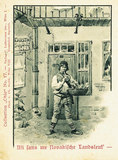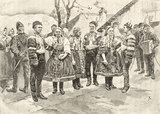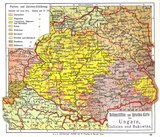-

Slovakian pedlar in Vienna, picture postcard from the series “Cries of Vienna”, around 1895
Copyright: IMAGNO/Austrian Archives
-

Ladislaus Kimnach: Slovak costumes from the region of Thyrnau/Trnava, Illustration, 1898
Copyright: Schloß Schönbrunn Kultur-und Betriebsges.m.b.H./Fotograf: Alexander E. Koller
-

Map of the nationalities and languages of Hungary, from : Prof. Anton Leo Hickmanns geographisch-statistischer Taschen-Atlas von Österreich-Ungarn (Vienna, 1900)
Copyright: Schloß Schönbrunn Kultur-und Betriebsges.m.b.H.
Partner: Schloss Schönbrunn Kultur- und Betriebsges.m.b.H.
The Slovaks comprised one of the smaller nationalities in the multi-ethnic Habsburg Empire. In 1910 around 2.1 million people professed their adherence to the Slovakian linguistic group, 3.8 % of the population of the total Monarchy.
The Slovaks were mainly settled in the Hungarian half of the empire, with a 10.7 % share of the population. In Cisleithania they were not identified separately but counted along with the Czechs as part of the Czechoslavic group of people.
The heartland of the Slovaks was in the northwestern counties of the historical Kingdom of Hungary – a region then called Upper Hungary. In the west the Slovakian settlement areas overlapped national borders because in the southeast Moravian lowland of the March there was a fluid transition to the Czech-Moravian linguistic region. In the northern and eastern mountainous regions of the Carpathians an exact demarcation from the Polish and Ruthenian mountain populations was again difficult to identify, because the local dialects also presented problems in assigning them to one or the other linguistic group.
In the eighteenth century Slovaks were involved in the re-settlement of Hungary after the devastations of the Turkish Wars. Settlements of Slovakian colonists sprang up for example in the region around Budapest, in the Hungarian plain, and in Slavonia and the Banat.
In the late nineteenth century 70 % of the Slovaks worked on the land, still characterised in this region mainly by the smallest of smallhold farms and outdated production methods and technologies. Massive over-population led to a strong trend towards emigration, since industrialisation had scarcely taken hold in this region. Slovaks moved as agricultural labourers to inland Hungary and Lower Austria. Migration furthermore brought many Slovaks to the now rapidly growing capital of Budapest. Here they were subjected to great pressure to assimilate and were quickly Magyarised. The Slovakian immigrants played a similar role here to the Czechs in Vienna. In 1881 6 % of the inhabitants of Budapest stated Slovakian as their mother tongue, in 1891 despite increasing immigration only 5.6 %. However, the official statistics present a distorted picture, because around 1910 there are estimates of around 100,000 persons in the Hungarian capital with Slovakian as their mother tongue, which would have corresponded then to something over 10 % of the resident population.
A huge wave of emigration brought thousands more Slovaks abroad. Around 1900, it is estimated that approximately 500,000 Slovaks emigrated to the USA.
Translation: Abigail Prohaska
Holotík, L’udovít: Die Slowaken, in: Wandruszka, Adam/Urbanitsch, Peter (Hrsg.): Die Habsburgermonarchie 1848–1918, Band III: Die Völker des Reiches, Wien 1980, Teilband 1, 775–800
Rumpler, Helmut: Eine Chance für Mitteleuropa. Bürgerliche Emanzipation und Staatsverfall in der Habsburgermonarchie [Österreichische Geschichte 1804–1914, hrsg. von Herwig Wolfram], Wien 2005
Rumpler, Helmut/Seger, Martin (Hrsg): Die Habsburgermonarchie 1848–1918, Band IX/2: Soziale Strukturen, Wien 2010


